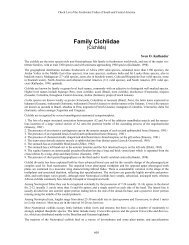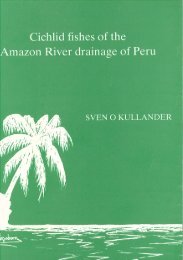Open Access PDF - Sven Kullander
Open Access PDF - Sven Kullander
Open Access PDF - Sven Kullander
You also want an ePaper? Increase the reach of your titles
YUMPU automatically turns print PDFs into web optimized ePapers that Google loves.
394<br />
mented, apparently mucus-filled, circular area<br />
slightly posterior to the nostril and at the dorsal<br />
margin of the nasorbital depression. This area<br />
represents probably a free neuromast; it can be<br />
probed into the skin, but does not seem to represent<br />
an opening to the nasal sac, instead it may<br />
be related to the multiple perforations connecting<br />
to the anterior nasal lateralis canal opening. Preliminary<br />
observations suggest that this character<br />
is also present in other cichlids.<br />
Geographical distribution. Most species of Cichla<br />
now known conform to a general pattern of<br />
allopatric distribution, although several species<br />
are sympatric or even syntopic. This suggests that<br />
Cichla is a component of a general species distribution<br />
pattern in tropical South America. Limiting<br />
factors are sometimes obvious, with elements<br />
of isolation to or above major rapids (C. thyrorus,<br />
C. melaniae, C. mirianae, C. jariina), restriction to<br />
certain water conditions, e.g., blackwaters (C. temensis,<br />
C. orinocensis) or clearwater rivers (C. piquiti,<br />
C. melaniae, C. mirianae, C. thyrorus, C. jariina),<br />
as is known from other cichlids. The historical<br />
patterns are more obscure. The species pattern<br />
does not retrace that of other cichlid genera and<br />
the tree (Fig. 93) shows a complex geographic<br />
branching.<br />
Essentially, the distribution of the genus recovers<br />
the Guianan and Brazilian highlands. Cichla<br />
monoculus is exceptional in its wide floodplain<br />
distribution in the western Amazon basin, but<br />
there is too little information about the fish fauna<br />
of tributaries to conclude if it is really restricted<br />
to floodplains. Cichla monoculus extends eastwards<br />
to the mouth of the Amazon and occurs also in<br />
the Oyapock drainage. It is represented by similar<br />
species in Bolivia (C. pleiozona) and the Rio<br />
Tocantins (C. kelberi). Cichla ocellaris is the only<br />
species occurring in several rivers in the Guianas,<br />
but also in the Rio Branco. The putative sister<br />
species is C. nigromaculata in the upper Orinoco<br />
and Negro rivers.<br />
Cichla vazzoleri and C. pinima occur in tributaries<br />
below major rapids east of the Rio Negro and<br />
Rio Madeira, but restricted to opposite sides of<br />
the Rio Amazonas. Cichla from the Amapá are<br />
identified as C. pinima, but based on limited material.<br />
Two species, C. orinocensis and C. temensis<br />
are distributed over two major river drainages,<br />
the Negro and the Orinoco, which, however, are<br />
incompletely separated being connected across<br />
the Rio Casiquiare. Cichla ocellaris is recorded from<br />
both the Rio Branco and several rivers in Guyana<br />
and Suriname.<br />
Species of Cichla are remarkably similar to<br />
each other in body proportions and most meristics.<br />
Colour variation provides the best species<br />
diagnostic characters. In this regard Cichla conforms<br />
to other genus-level taxa of cichlids in South<br />
America, which are morphologically distinct, but<br />
within each genus species differ principally in<br />
colour pattern. Since cichlids are diurnal, and<br />
effect an elaborate behaviour including visual<br />
clues in social interaction, this is not surprising.<br />
More surprising is that other morphological differentiation<br />
tends to be limited. Possible explanations<br />
could be that the generic subdivisions among<br />
cichlids are biased towards recognizing units<br />
separated by morphological gaps, that morphological<br />
key innovations are functional in stable<br />
communities not permitting radiating evolution,<br />
or biased or incomplete character sampling.<br />
Clearly, patterns of variation in colour and<br />
meristics are easier to perceive than other aspects<br />
of the type of organisms represented by Cichla<br />
and other cichlids. Silfvergrip (1996), working<br />
with a genus of nocturnal catfishes over the entire<br />
Neotropics, found surprisingly few species in a<br />
total analysis approach, where others have easily<br />
described species by comparing just selected<br />
geographical samples. The conclusion is that<br />
colour variation greatly facilitates species recognition.<br />
Whereas genera of cichlids are recognized<br />
by gaps, phylogenetic morphological and molecular<br />
analyses support about the same branching<br />
patterns of genera (e.g., <strong>Kullander</strong>, 1988;<br />
Farias et al., 2001), and it thus seems likely that<br />
morphological characters are reasonably well<br />
sampled and consequently genera are reasonable<br />
approximations of monophyletic morphologybased<br />
clades. Clearly, ecological functional constraints<br />
may be the most plausible explanation<br />
for the pattern shared by Cichla and other cichlid<br />
genera with a more or less consistent allopatry of<br />
included species – whenever there is vicariance<br />
followed by speciation, colour divergence is the<br />
most obvious marker of speciation. It is hard to<br />
think that all intrageneric cichlid speciation would<br />
represent very recent isolation, with insufficient<br />
time for further differentiation.<br />
Under this functional constraint hypothesis,<br />
changes in characters not affecting the basic body<br />
plan and consequently feeding ecology, would<br />
have little effect on the ecological function of the<br />
new species, but mutations relating to the com-<br />
<strong>Kullander</strong> & Ferreira: Review of Cichla




